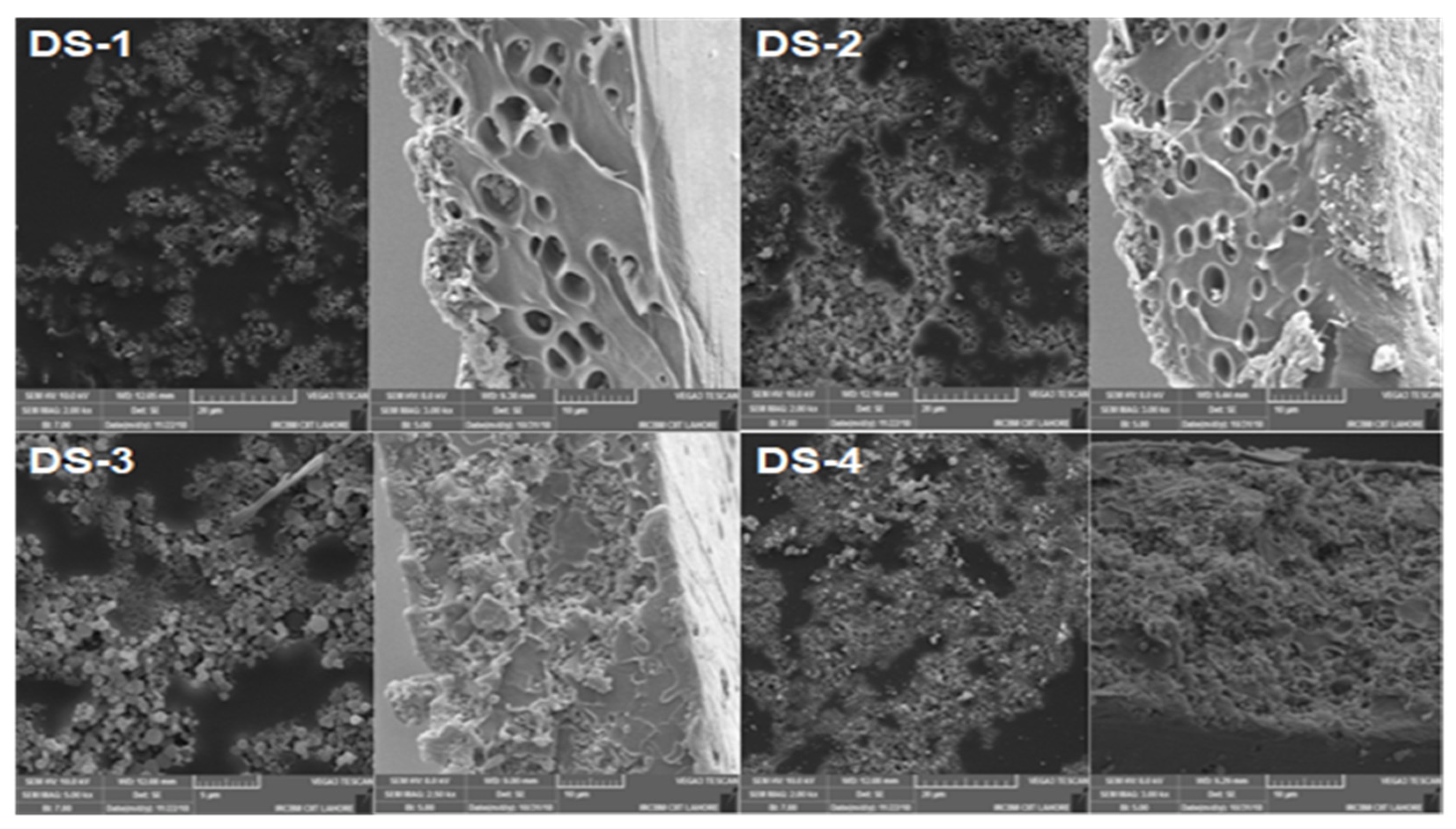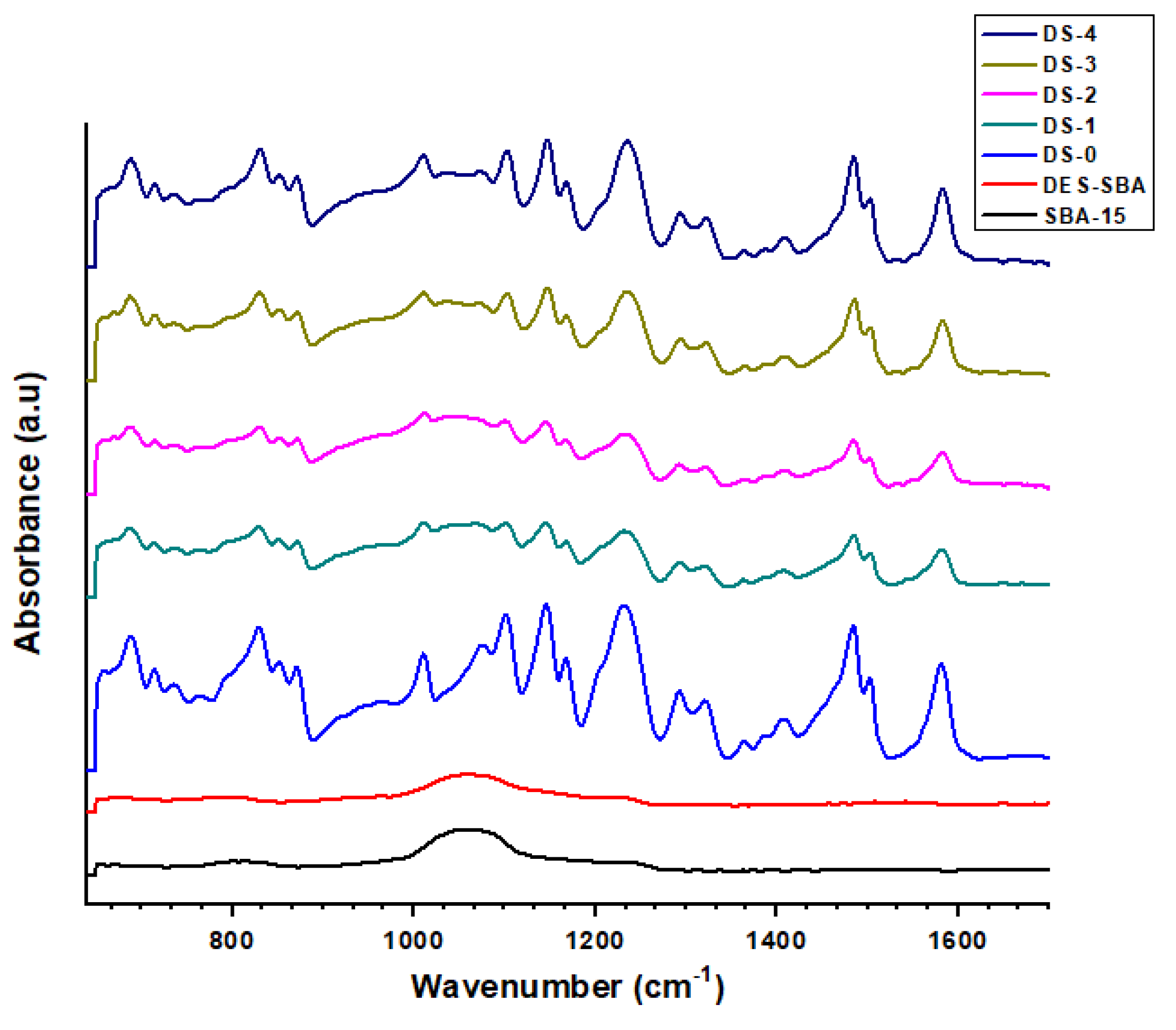Deep Eutectic Solvent-Functionalized Mesoporous Silica SBA-15-Based Mixed Matrix Polymeric Membranes for Mitigation of CO2 †
Abstract
:1. Introduction
2. Methods
2.1. Synthesis of SBA-15
2.2. Synthesis of Deep Eutectic Solvent
2.3. Functionalization of SBA-15 by DES
2.4. Synthesis of Mixed Matrix Membranes
3. Results and Discussion
3.1. Scanning Electron Microscope (SEM)
3.2. Fourier Transform Infrared Spectroscopy (FTIR)
3.3. Gas Permeation Analysis
4. Conclusions
References
- Cavenati, S.; Cavenati, S.; Grande, C.A.; Rodrigues, A.E. Removal of carbon dioxide from natural gas by vacuum pressures wing adsorption. Energy Fuels 2006, 20, 2648–2659. [Google Scholar] [CrossRef]
- Zhang, Y.; Sunarso, J.; Liu, S.; Wang, R. Current status and development of membranes for CO2/CH4 separation:A review. Int. J. Greenh. Gas Control 2013, 12, 84–107. [Google Scholar] [CrossRef]
- Houghton, J.T.; Ding, Y.; Griggs, D.J.; Noguer, M. Climate Change 2001: The Scientific Basis; The Press Syndicate of the University of Cambridge: New York, NY, USA, 2001. [Google Scholar]
- Koros, W.J.; Mahajan, R. Pushing the limits on possibilities for large scale gas separation: Which strategies? J. Membr. Sci. 2000, 175, 181–196. [Google Scholar] [CrossRef]
- Basu, S.; Khan, A.L.; Cano-Odena, A.; Liu, C.; Vankelecom, I.F. Membrane-based technologies for biogas separations. Chem. Soc. Rev. 2010, 39, 750–768. [Google Scholar] [CrossRef] [PubMed]
- Burleigh, M.C.; Markowitz, M.A.; Spector, M.S.; Gaber, B.P. Direct synthesis of periodic mesoporous organosilic as: Functional incorporation by co-condensation with organosilanes. J. Phys. Chem. B 2001, 105, 9935–9942. [Google Scholar] [CrossRef]
- Zhao, D.; Huo, Q.; Feng, J.; Chmelka, B.F.; Stucky, G.D. Nonionic triblock and star diblock copolymer and oligomeric surfactantsynthesis of highly ordered, hydrothermally stable, mesoporous silica structures. J. Am. Chem. Soc. 1998, 120, 6024–6036. [Google Scholar] [CrossRef]
- Rehman, F.; Volpe, P.L.; Airoldi, C. The applicability of ordered mesoporous SBA-15 and its hydrophobic glutaraldehyde-bridge derivative to improve ibuprofen-loading in releasing system. Colloids Surf. B: Biointerfaces 2014, 119, 82–89. [Google Scholar] [CrossRef] [PubMed]
- Shahbaz, K.; Mjalli, F.S.; Hashim, M.A.; AlNashef, I.M. Using deep eutectic solvents based on methyltriphenyl phosphunium bromide for the removal of glycerol from palm-oil-based biodiesel. Energy Fuels 2011, 25, 2671–2678. [Google Scholar] [CrossRef]
- Durand, E.; Lecomte, J.; Villeneuve, P. Deep eutectic solvents: Synthesis, application, and focus on lipase-catalyzed reactions. Eur. J. Lipid Sci. Technol. 2013, 115, 379–385. [Google Scholar] [CrossRef]
- Saqib, S.; Rafiq, S.; Muhammad, N.; Khan, A.L.; Mukhtar, A.; Mellon, N.B.; Jamil, F. Influence of interfaciall ayer parameters on gas transport properties through modeling approach in MWCNTs based mixed matrix composite membranes. Chem. Eng. Sci. 2020, 218, 115543. [Google Scholar] [CrossRef]



| Membrane | Composition | PSF | DES-SBA | THF |
|---|---|---|---|---|
| DS-0 | PSF | 4.8 | - | 95.2 |
| DS-1 | DES-SBA 5% | 4.8 | 0.238 | 94.962 |
| DS-2 | DES-SBA 10% | 4.8 | 0.476 | 94.724 |
| DS-3 | DES-SBA 15% | 4.8 | 0.714 | 94.486 |
| DS-4 | DES-SBA 20% | 4.8 | 0.952 | 94.248 |
Publisher’s Note: MDPI stays neutral with regard to jurisdictional claims in published maps and institutional affiliations. |
© 2022 by the authors. Licensee MDPI, Basel, Switzerland. This article is an open access article distributed under the terms and conditions of the Creative Commons Attribution (CC BY) license (https://creativecommons.org/licenses/by/4.0/).
Share and Cite
Saif-ur-Rehman; Zaman, M.K.U.; Ahsan Waseem, M.; Zaman, S.U.; Shozab Mehdi, M. Deep Eutectic Solvent-Functionalized Mesoporous Silica SBA-15-Based Mixed Matrix Polymeric Membranes for Mitigation of CO2. Eng. Proc. 2021, 12, 61. https://doi.org/10.3390/engproc2021012061
Saif-ur-Rehman, Zaman MKU, Ahsan Waseem M, Zaman SU, Shozab Mehdi M. Deep Eutectic Solvent-Functionalized Mesoporous Silica SBA-15-Based Mixed Matrix Polymeric Membranes for Mitigation of CO2. Engineering Proceedings. 2021; 12(1):61. https://doi.org/10.3390/engproc2021012061
Chicago/Turabian StyleSaif-ur-Rehman, Muhammad Khaliq U Zaman, Muhammad Ahsan Waseem, Shafiq Uz Zaman, and Muhammad Shozab Mehdi. 2021. "Deep Eutectic Solvent-Functionalized Mesoporous Silica SBA-15-Based Mixed Matrix Polymeric Membranes for Mitigation of CO2" Engineering Proceedings 12, no. 1: 61. https://doi.org/10.3390/engproc2021012061
APA StyleSaif-ur-Rehman, Zaman, M. K. U., Ahsan Waseem, M., Zaman, S. U., & Shozab Mehdi, M. (2021). Deep Eutectic Solvent-Functionalized Mesoporous Silica SBA-15-Based Mixed Matrix Polymeric Membranes for Mitigation of CO2. Engineering Proceedings, 12(1), 61. https://doi.org/10.3390/engproc2021012061






